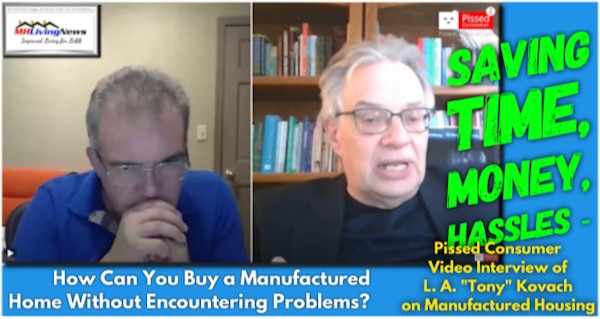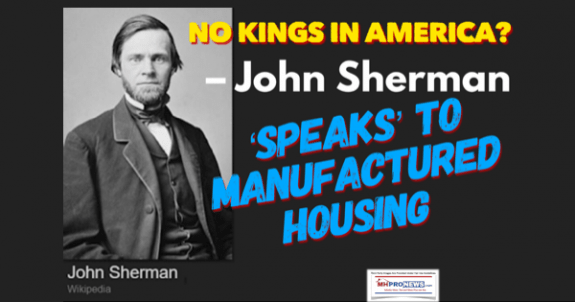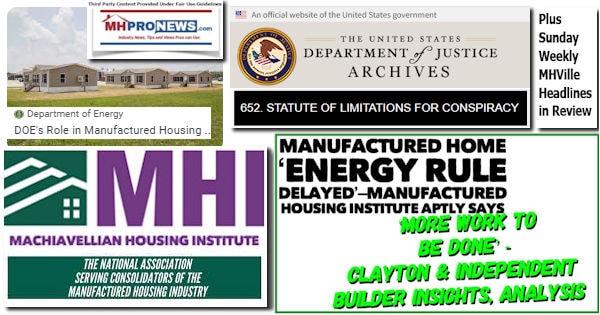
The Manufactured Housing Institute (MHI) sent the following email to those on the Arlington, VA based trade association’s MHI email list on May 19, 2023. They touted that the DOE Energy Rule has been “delayed” and that “There is Still Work to be Done.” Both of those remarks are true, but. That “but” hinges in part on the slippery nature of paltering. Left-leaning Wikipedia says: “Paltering is the active use of selective truthful statements to mislead.” For an example of paltering in MHVille, MHI fails to admit their role in causing the DOE energy rule’s formation. MHI failed to mention that they delayed launching the litigation which the Manufactured Housing Association for Regulatory Reform (MHARR) – and this platform – repeatedly pressed them to do for months before MHI finally acted. They also fail to mention in their email that the legislation that they launched in 2022 (HR 7651 – about a year ago) – which obviously failed to pass – had nearly no chance for being enacted in the first place, as MHProNews’ Masthead (editorial) blog predicted would that it would fail months in advance. There is more, some of which may be the apparent threat of the DOE regulations being part of a ‘moat’ move by Clayton Homes, which has held a dominating role at MHI and among their state association affiliates, per a source at MHEC and others. That “moat” move in the DOE energy rule’s history is arguably a threat to any independent that doesn’t want to sell out to one of the big three producers at MHI.
More facts, analysis, and industry expert views in the commentary that follows are in Part I, which provides the essence of MHI’s statement to industry members. Note that because email is used that may fall under RICO and other statues.
Part II includes additional information with more MHProNews Analysis and Commentary in Brief. Note that MHARR said weeks ago to their readers that the DOE manufactured housing energy rule had been delayed. Part I is ideally read in the context of what MHARR said to industry readers at this link below.
Part III of this report is our weekly manufactured housing headlines in review. Those headlines will in several ways elaborate on related information about the manufactured home industry consolidators who have reportedly steadily taken over MHI since early in the 2000s.
Postscript – Part IV. Clayton Homes media release which isn’t mentioned by MHI, but arguably should be. That segment may be of particular interest to all MHARR members as well as to all other independents in the manufactured housing industry. Properly understood, every consolidation ploy should be of interest to those working for any of the consolidators at MHI. One of the reports for the week in review will deal with that issue in depth, but others mention it too. With that plan for this report, let’s dive into Part I – the remarks from MHI’s so-called “housing alert.”
Part I
 HOUSING ALERTMay 19, 2023
|
|
Part II – Additional Information with More MHProNews Analysis and Commentary in Brief
Once someone in manufactured housing, investors, public officials, or other researchers/advocates grasp the notion that MHI often uses paltering in their messaging, a range of insights based upon known facts begins to emerge from the above MHI “Housing Alert” as well as numbers of their other statements and claims.
In no particular order of importance, the following MHProNews editorial insights are relevant to their remarks above.
- 1) For months, MHI is not known to have said anything in their general messaging to the manufactured home industry about litigation. MHARR and MHProNews led the charge early and often that litigation was needed to stop the MHI rule. MHARR’s report, linked here and here, beg the question: would MHI have sued at all without MHARR’s spotlight on the weaknesses in the DOE positions? These historic links from MHARR and MHProNews, it should be stressed, have no apparent counterparts on the MHI website that are known to mention litigation prior to their suit with the Texas Manufactured Housing Association (TMHA) in their Valentine’s Day Case No. 23-cv-00174 being launched. There are several reasons why this matters. Among them? If MHI had signaled early and often that they would sue DOE if their rule wasn’t going to be modified, then the DOE may have taken an entirely different position.
August 2022 MHARR Issues and Perspectives – “WHY THE DOE ENERGY RULE SHOULD BE DOA”
- 2) Part IV (today’s postscript) will explore an issue that was speculated on previously by MHProNews but which Clayton and MHI may have now de facto clarified. Namely, has MHI and their dominating brands used the DOE rule as a moat move? The answer appears to be yes, and the Clayton Homes news release and related analysis and commentary will shed light on that concern. Affordable housing advocates, renters who thirst to become homeowners, investors, manufactured housing independent producers, public officials, taxpayers, and others are among those harmed by MHI’s problematic role in this entire DOE fiasco. The publicly unchallenged role of MHI in causing the DOE rule is explored in depth and with documentation in the exclusive report linked here. For MHI to crow about their achievement and strategy is not only premature, but MHI is apparently being deceptive. It is akin to an arsonist starting a fire and then calling the fire department. Even the TMHA said, prior to the suit with MHI being launched, that the harm to manufactured housing was difficult to calculate but costly.
- 3) MHI arguably waited too long to file suit, as it caused unnecessary stresses and costs on others in the industry. Again, it is the TMHA and MHI themselves who have helped make that “irreparable harm” argument. With that backdrop in mind, deep thinkers might wonder. Did any finalized or potential consolidations of factories into the Cavco Industries (CVCO) (or other “big three”) corporate umbrellas occur in part due to the costs, risks, market, and regulatory pressures that include the DOE energy rule?
- 4) Additionally, keep in mind the observations and facts by expert sources shown below. Regulations harm independents more than larger firms. Larger firms know this to be the case.
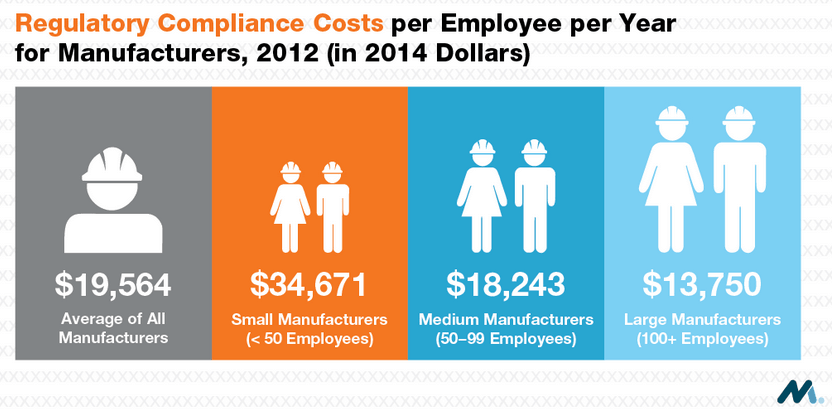
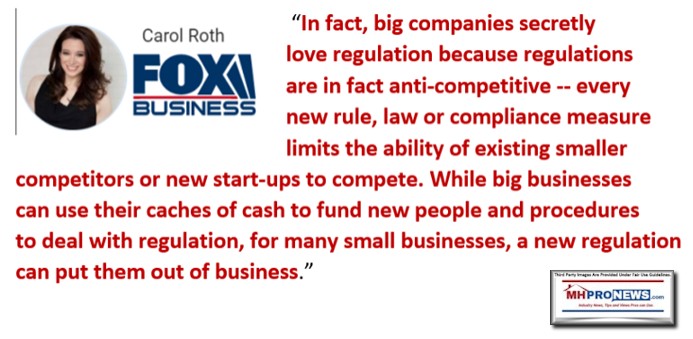
- 5) MHI arguably hates public criticism. Despite MHI’s apparently deceptive claim to ‘seek all viewpoints,’ there is clear evidence to the contrary. See the remarks by an outside MHI attorney, David Goch in detail linked here with analysis, and also referenced below. Yet, despite MHI obviously loathing a serious public critique, MHI is not known to have pushed back against any of the exposes posted by MHProNews or remarks published by MHARR that reference MHI on this DOE energy rule issue. Now that MHI has been nudged into this lawsuit, it begs the question. What excuse does MHI now have for not filing suit to get the industry’s rights enforced under the Manufactured Housing Improvement Act (MHIA) of 2000, notably, the MHIA’s “enhanced preemption” provision? Similarly, what excuse can MHI give for not filing suit on issues related to the Housing and Economic Recover Act (HERA) of 2008, and its Duty to Serve (DTS) manufactured housing mandates? It is a law professor who de facto mocked MHI when he said that the manufactured home industry needed an advocacy group that would also litigate. Ouch. That once more begs the questions. When will MHI act legally with the FHFA? Or with Fannie Mae or Freddie Mac? Why didn’t MHI join in on the letter from manufactured housing advocates to get the FHFA to push the GSEs of Fannie and Freddie to provide a securitized access to the secondary finance market for manufactured home chattel loans? For that last question, see the report for the week that was that explored Raymond Leech with Berkshire Bank’s commentary on the manufactured home industry. Spoiler alert: Leech worked with for Fannie Mae for nearly 3 decades.
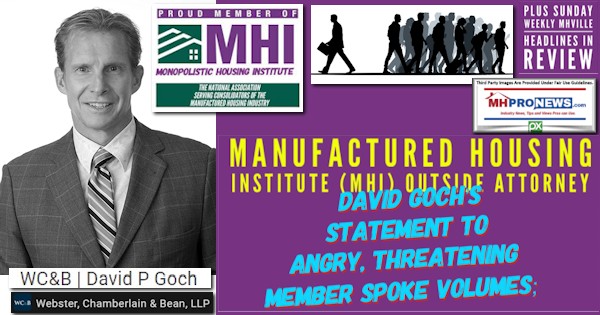
- 6) Restating #5 and building on it, MHI and their corporate masters have logically boxed themselves into several corners on key manufactured housing issues. Now that MHI has finally used litigation in at least a partially successful manner (buying time, arguably insufficient if further sound follow ups aren’t taken, but a useful step), how can MHI explain their not suing on DTS or the MHIA’s enhanced preemption? If after nearly 15 years (DTS) and 22 plus years (MHIA-enhanced preemption) MHI has failed to sue and do so in an effective fashion, it should cause even loyal MHI members to wonder, why not? If MHI finally does sue, then the obvious question should be – why have they waited for over 2 decades on the MHIA and preemption? Or some 15 years on DTS? Recall that MHARR offered to work with MHI state affiliates four years ago. Reportedly no one accepted. That was hardly a first time for MHARR to press for such action.
“THE INCREDIBLE SHRINKING ZONING PROBLEM.”-SEPTEMBER 2019 MHARR ISSUES AND PERSPECTIVES
- 7) There is much more that could be said on this DOE issue, such as the obviously posturing failure of MHI on their newly proposed legislation. As MHARR pointed out repeatedly over the years, there has been “an illusion of motion” at MHI. They posture action or a rationale that sounds plausible. But MHI routinely fails to do what is logical and common sense. What may seem intelligent to those not seasoned in Washington, D.C. politics, MHI’s latest bill may sound fine. But veteran lobbyists might privately mock their effort as absurd on its face. As MHProNews has reported and observed for years, those failures by MHI’s leaders can’t be the result of mere garden variety ineptitude. Rather, they are evidence of a pattern of posturing, paltering, preening for photo ops all occurring while the industry steadily consolidates. Note the report below was published prior to the DOE lawsuit by MHI-TMHA.
- 8) Regarding the MHI backed legislation last year, MHProNews made clear early on that it was doomed to fail, citing experts and sources such as Skopos Labs and GovTrack. While their new bill is ‘improved’ in the sense that it has a Democrat as a co-sponsor, it is arguably still only posturing. Why? Because there is no Senate companion bill. You don’t have to have a Ph.D. in political science, as the documented and arguably corrupt MHI CEO Lesli Gooch does, to know that you need two identical bills in the House and Senate to pass and then you need a president to sign a passed bill into law at the federal level. Even if there was bipartisan support and identical House-Senate legislation, the odds that Joe Biden would veto it are all but guaranteed. Meaning, MHI’s new bill would require a veto proof bipartisan effort to make this law. Democrats are unlikely to give up on their energy agenda. Rephrased, MHI’s new legislative effort is another waste of time and money. Thus, the unstated but actual reason that it is logically being launched is for posturing purposes by MHI. MHI and their dominating corporate masters may get others ancillary benefits, such as their opportunity to pick up potentially a few more email addresses for their mailing lists.
- 9) Put differently, MHI has been playing what MHARR’s President and CEO called in an exclusive Q&A with MHProNews a “shell game.” Ex-MHI Vice President Danny Ghorbani, the founding president and CEO of MHARR, said over a year ago that MHI was posturing and preening for photo ops, but was “bereft” of any tangible results. Meanwhile, the manufactured housing industry is once more in month 6 of a downturn.
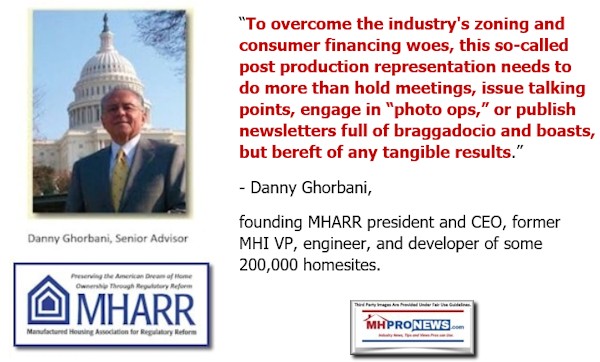
- 10) Arguably related, an MHI insider recently told MHProNews that the industry will never recover to its previous levels in our lifetime. That’s a damning indictment of MHI’s apparent treachery.
At least seemingly related to those remarks cited above are voices within MHI that politely- to bluntly-ripped their own trade group and/or left the MHI association.
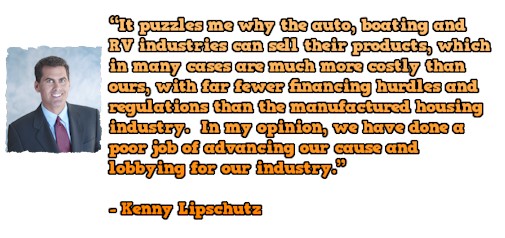
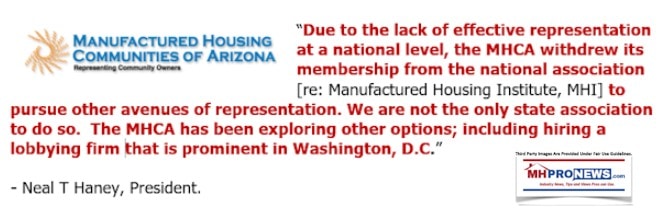
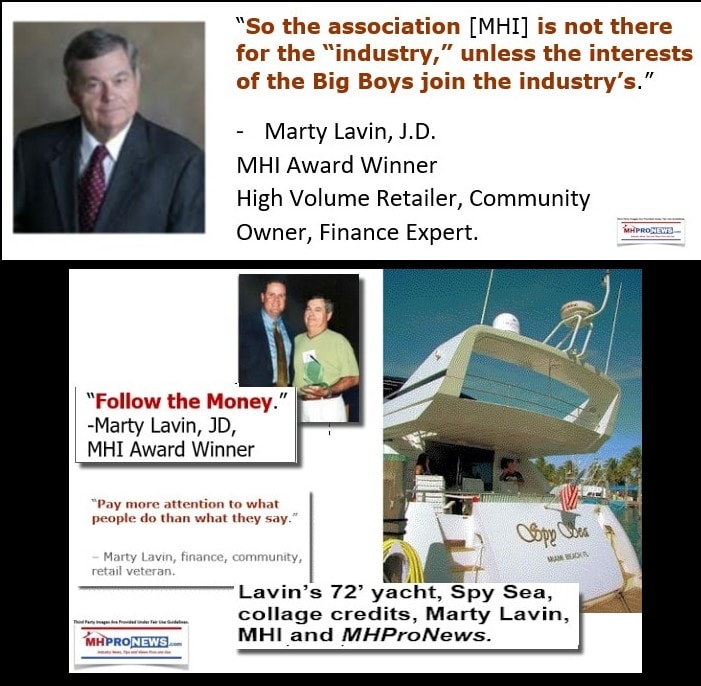
Despite being an MHI award-winner, perhaps due to his published disagreements with their work on certain issues, Lavin’s name was not found on the MHI website.
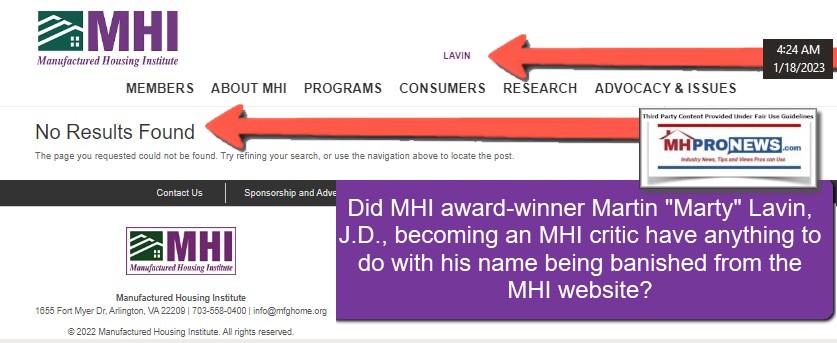
It is with that backdrop that the Clayton Homes angle in this mix should be explored. See the Postscript – Part IV, further below.
That relatively focused analysis helps tee up the headlines for the week that was in manufactured housing. How so? Because manufactured housing is demonstrably underperforming during an affordable housing crisis.
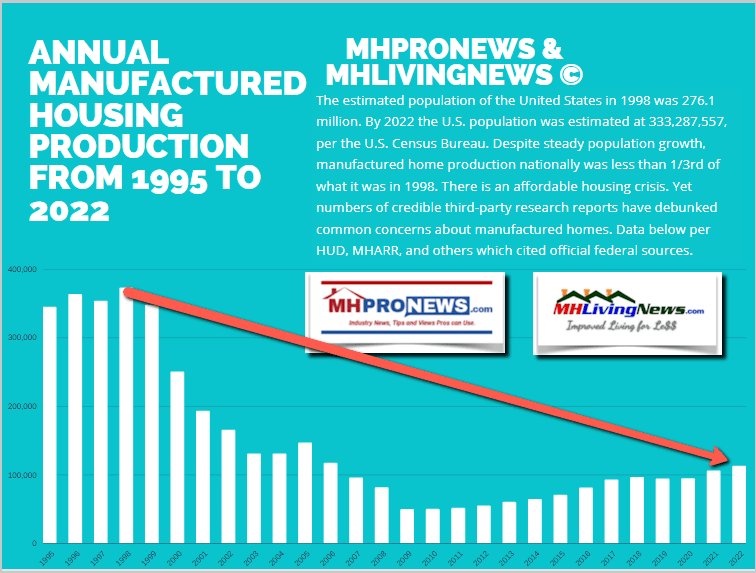
Recall that some 9 years ago, then MHI President and CEO Richard “Dick” Jennison said that the industry should grow slowly. What? That remark was one of a series of eye opening events that began the ‘awakening’ of this platform’s management to what the true nature of MHI had become.
Ironically, the press by MHProNews with former MHI chairman, still MHI board member, and current 21st Mortgage Corporation President and CEO Tim Williams apparently led to Jennison supposedly ‘clarifying’ his comments above and praising MHProNews in the process.
MHI and their corporate masters can’t have it both ways. They have long ago intellectually boxed themselves into corners on several key issues.
As another example. They can’t have their president and CEO proclaiming in front of dozens of manufactured housing industry professionals that the industry could once more sustainably achieve 500,000 new homes produced annually. Then, they can’t try to excuse the fact that the industry is struggling to do 100,000 in homes in 2023. The shackles on our industry, it has been revealed, certainly have outside factors, as MHProNews has faithfully reported. But the tool of choice repeatedly used by MHI insiders in keeping the industry’s performance ‘shackled’ has been the “f-cking greedy” members of MHI itself (per an active member there).
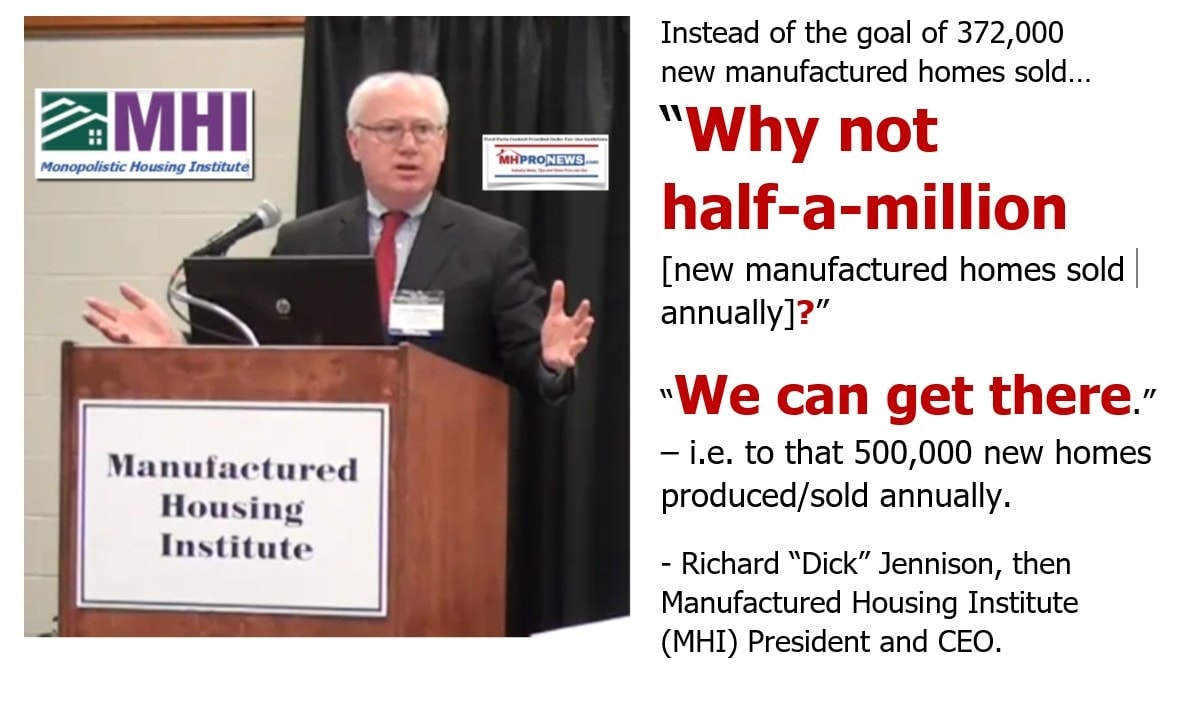
Once more, let’s note that these exposes of MHI and their dominating brands ARE NOT a slam on all MHI members. Several MHI members have little or no actual power at MHI. Some MHI members may have begun with trust in the organization but have since learned that they are being duped or lied to on a range of issues.
But there is clear evidence that some MHI members ‘rule’ MHI as a kind of oligarchy. It was Sam Zell, quoted in the first linked report below, who said he liked the oligarchical nature of his segment of the industry. That should cause thinking people to wonder if that same oligarchical nature holds for all other aspects of MHI. Antitrust researcher Samuel “Sam” Strommen answered that by saying that MHI and some of their key brands apparently are guilty of “felony” antitrust violations.
With no further adieu, here are the reports and headlines in this Sunday’s recap for the week from 5.14.2023 to 5.21.2023.
Part III
What’s New and Recent on MHLivingNews
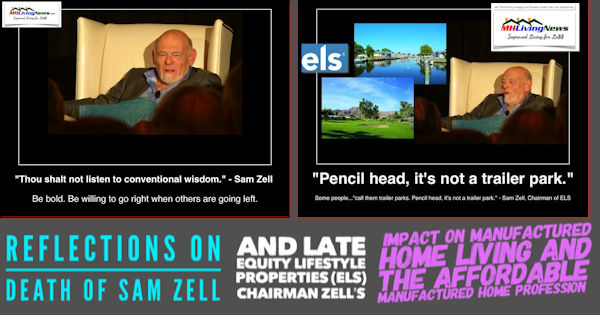

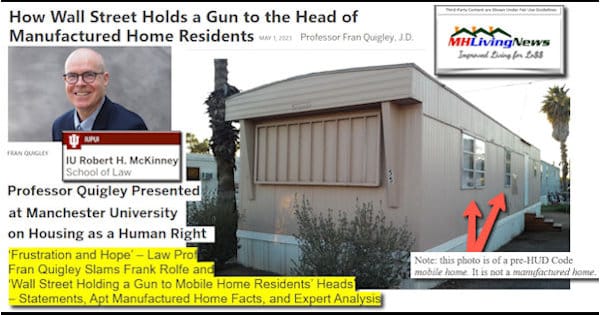
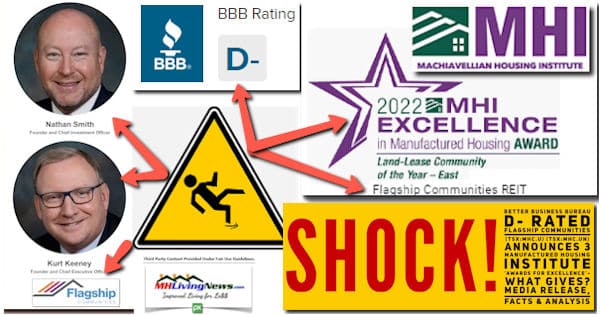
What’s New from Washington, D.C. from MHARR

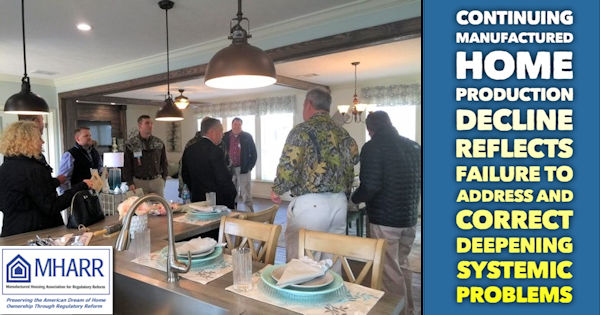
What’s New and Recent on the Masthead
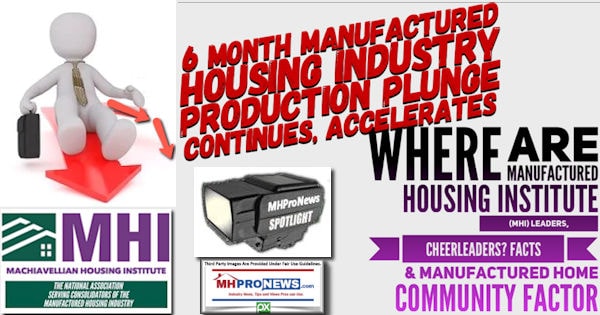


What’s New on the Daily Business News on MHProNews
Saturday 5.20.2023
Friday 5.19.2023
Thursday 5.18.2023
Wednesday 5.17.2023
Tuesday 5.16.2023
Monday 5.15.2023
Sunday 5.14.2023
Postscript
Notice: providing Clayton Homes content should NOT be construed as an endorsement of the organization, nor of their affiliates, nor as a face value acceptance of their statements. Examples of arguably deceptive and concerning messaging by Kevin Clayton is shown linked here and following their release below.
Part IV Clayton Homes press release on an arguably related topic to MHI’s, namely, the DOE energy rule and related regulations. Hotlinks have been removed, but the content is otherwise as they published it.
NEWS PROVIDED BY
Clayton
06 May, 2023, 06:00 ET
Clayton® Commits to Build All Residential Manufactured Homes to DOE Zero Energy Ready Home™ Specifications by End of 2023
Clayton Features Manufactured Home Built to DOE Zero Energy Ready Home Specifications at the 2023 Berkshire Hathaway Shareholders Meeting
OMAHA, Neb., May 6, 2023 /PRNewswire/ — Clayton, a builder of attainable housing, announced its move to build all new residential manufactured homes to Department of Energy (DOE) Zero Energy Ready Home specifications by January 1, 2024. These solar-ready homes, available to order in July 2023, will include enhanced energy efficiency features that significantly reduce energy costs for homeowners, while also supporting the company’s broader sustainability goals. At the 2023 Berkshire Hathaway Shareholders Meeting, Clayton is showcasing a home built to the DOE Zero Energy Ready Home specifications.
Experience the full interactive Multichannel News Release here: https://www.multivu.com/players/English/9130251-clayton-to-build-all-residential-manufactured-homes-to-doe-zero-energy-ready-home-specifications/
“We are driven to make energy efficient homes an attainable option for home buyers across the country,” said CEO Kevin Clayton. “Energy efficiency is crucial for lowering monthly utility costs and maintaining long-term affordability.”
DOE Zero Energy Ready Homes are built inside a certified building facility and are designed with energy-efficient features that can offset up to 100 percent of the home’s energy use when combined with a renewable energy system, such as solar panels. Every DOE Zero Energy Ready Home must meet rigorous efficiency requirements, making it less costly for homeowners if they choose to add solar in the future.
All Clayton DOE Zero Energy Ready Homes will be equipped with enhanced energy-efficient features, such as a Rheem® hybrid heat pump water heater, low-E windows with argon gas, SmartComfort® by Carrier high efficiency heat pump or gas furnace, ENERGY STAR® certified appliances, LED lighting throughout, an ecobee® smart thermostat and additional insulation. To deliver additional value to the consumer, Clayton will reinvest the credits received for building the certified homes to offset the cost of materials.
By January 1, 2024, Clayton plans to have 39 manufactured home building facilities nationwide DOE certified and building homes to DOE Zero Energy Ready Home specifications. This significant milestone is an extension of the company’s overall sustainability efforts. In 2014, Clayton began working toward its ISO® 14001:2015 program, the gold standard of environmental management systems, across all of its home building and supply facilities. Since then, the program has resulted in a significant reduction of waste in operations through improved resource management and landfill diversion efforts. Last year alone, Clayton diverted over 100 million pounds of waste from landfills through recycling efforts at their home building and supply facilities.
Clayton’s national sustainability efforts also include reducing emissions through practices such as fleet modernization and an increased investment in solar power at its home office and building facilities. In addition, Clayton, in partnership with the Arbor Day Foundation®, is committed to planting 4.47 million native trees by 2025 to help restore vital forest ecosystems across the country.
To learn more about Clayton’s growing sustainability efforts visit: https://www.claytonhomes.com/sustainability
About Clayton
Founded in 1956, Clayton is committed to opening doors to a better life and building happyness® through homeownership. As a diverse builder committed to quality and durability, Clayton offers traditional site-built homes and off-site built housing – including modular homes, manufactured homes, CrossMod® homes, tiny homes, college dormitories, military barracks and apartments. In 2022, Clayton built 62,620 homes across the country. Clayton is a Berkshire Hathaway company. For more information, visit claytonhomes.com.
CrossMod is a registered trademark of the Manufactured Housing Institute.
ISO is the registered trademark of the International Organization for Standardization. ENERGY STAR is a registered trademark owned by the U.S. Environmental Protection Agency.
DOE Zero Energy Ready Home is a trademark of the U.S. Department of Energy.
SOURCE Clayton ###
Additional Information with MHProNews Analysis and Commentary in Brief
Clayton is a purported master of deception and misdirection, but fortunately Abraham Lincoln’s observation about catching liars in the act still holds true.

Lincoln’s pithy observation holds for much of MHVille that is apparently involved in consolidation of the industry. So long as recent remarks are compared to prior ones or by those of their members, bright line disconnects begin to emerge. Considering that those corporate leaders are often on the MHI board of directors, it is arguably an example of the Lincoln principle about liars later trapping themselves at work.
Additionally, since that board is legally obligated to work on behalf of all of their members, the disconnects become more legally concerning.
It seems apparent that Clayton is posturing itself to be ready to implement whatever the DOE decides to hand down, all with MHI’s history of ‘negotiated rule making’ collusion.
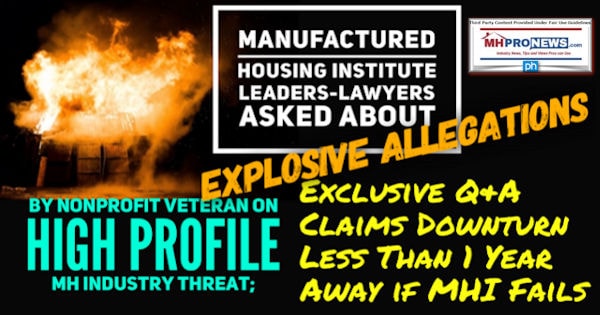

Note that MHProNews accurately said that a downturn was coming. Within months, that downturn began. MHProNews repeatedly warned industry members that when MHI says “momentum,” the opposite of that should be considered because of their prior history.
MHI and their leadership can’t hide as they once did behind paltering, posturing, and preening, deception and misdirection, etc. Once this publication’s leadership began to grasp the sinister nature of MHI, we systematically began to document the evidence. Now, that body of evidence is so large that MHI, their corporate and staff leadership, nor their outside attorneys are willing to debate or dispute the increasingly obvious. The industry’s leadership have an unstated agenda. That agenda ironically is exposed by MHI’s own members in their own corporate earnings calls, press releases, and investors pitches. Namely, there is a thirst to consolidate the industry by MHI members of the balance of the industry. The evidence is clear and overwhelming. It can’t be brushed aside as a conspiracy theory or any other slurs that MHI and their surrogates have or may attempt to deploy. Cavco and other publicly traded companies have often provided the evidence that contradicts MHI’s thinly veiled defense of the problems that are routinely tied to their own behaviors. There is an affordable housing crisis. Cavco is correct in saying that the industry is poised to surpass conventional housing. Then why hasn’t it done so?
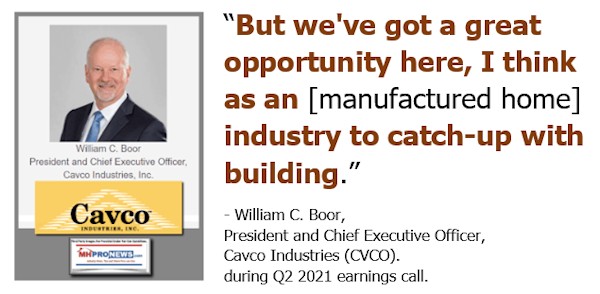
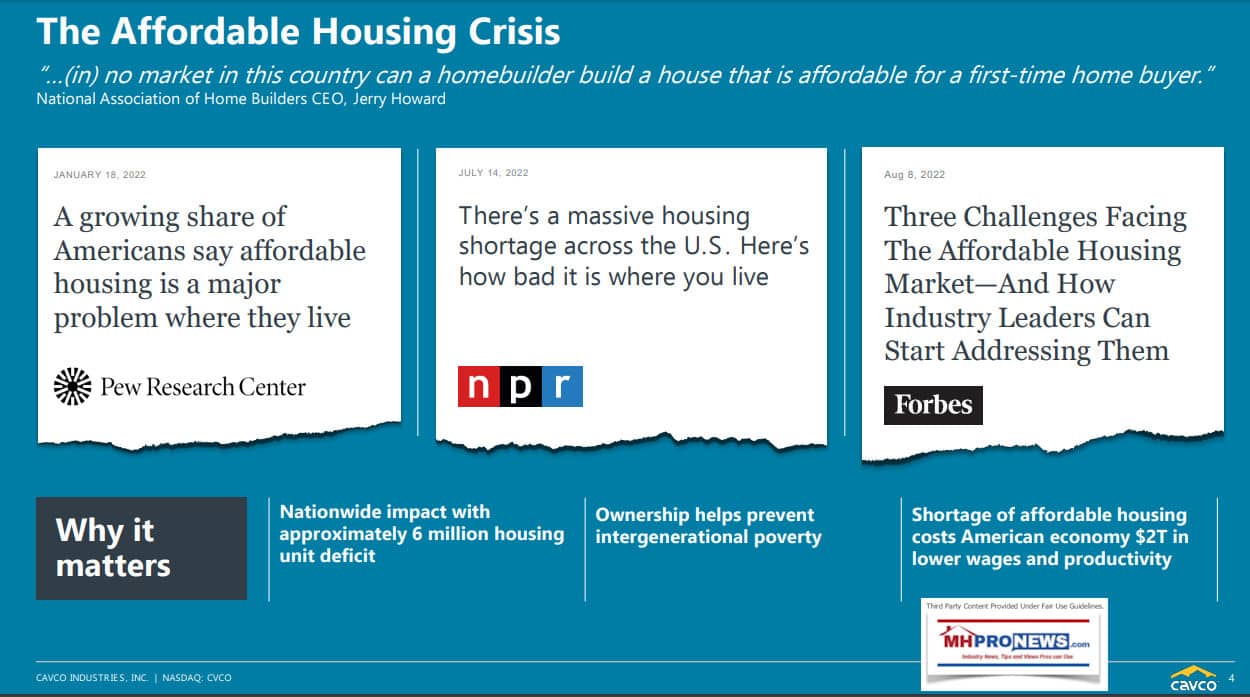
The headlines for the week that was, linked above, explore that pattern in detail. But the facts cited below from over a year ago still apply. The RV industry managed to break out of their prior production levels to achieve levels that now surpass manufactured housing. Andy Gedo, a loyal MHI member, admitted in the only published ‘great debate’ about the causes of the manufactured housing industry’s underperformance that it is useful to look to other industries for examples and insights. MHProNews is virtually alone in doing so, until MHI recently began their oblique series of arguably flawed responses.
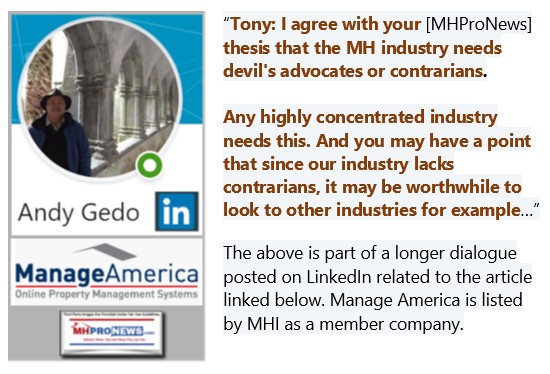
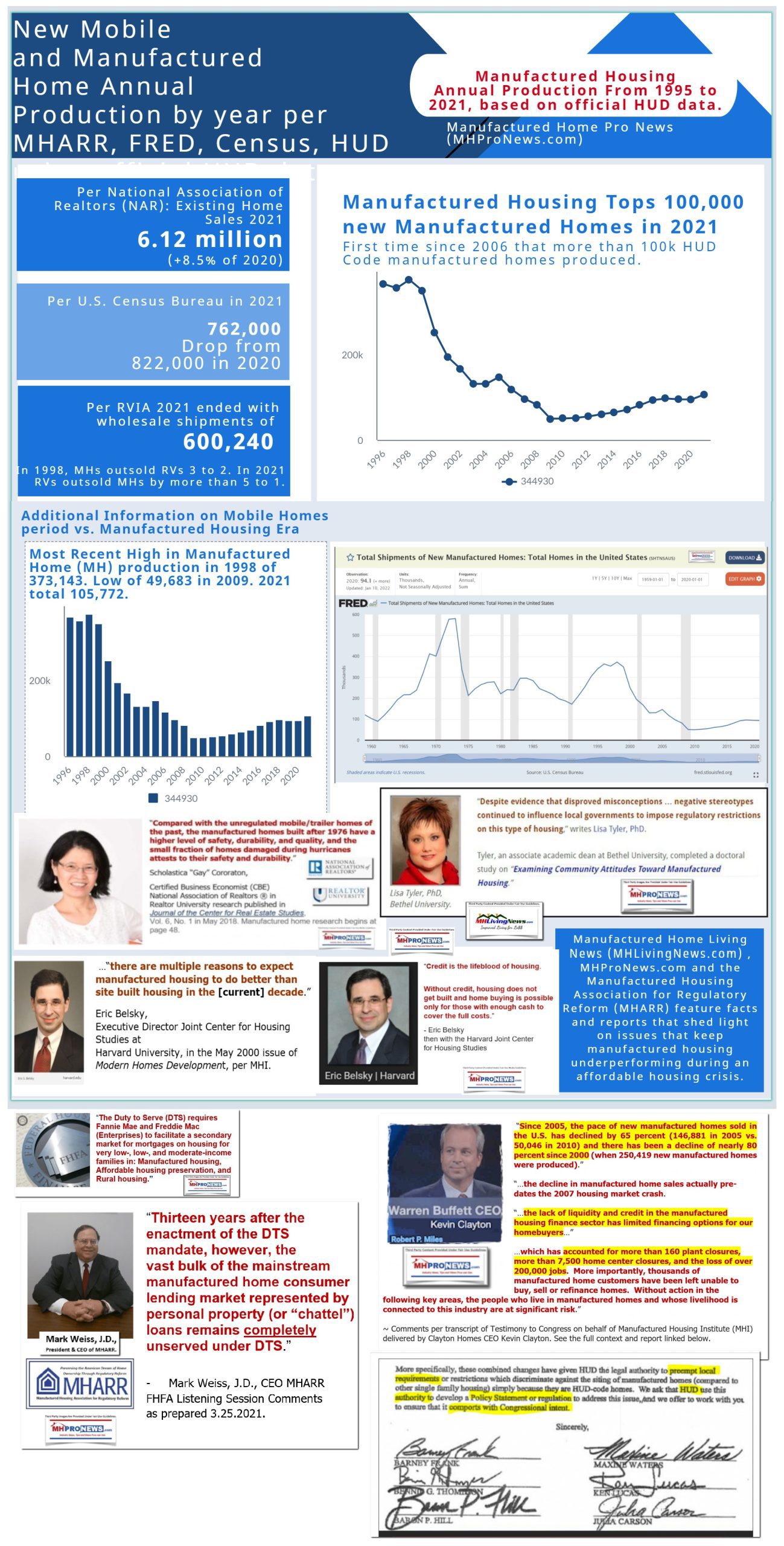
A key to understanding manufactured housing’s decades of underperformance is this remark by Warren Buffett ally Bill Gates. Gates understood Buffett well. He said that Buffett finds weaknesses in markets that he exploits in a parasitic fashion. The fabled Buffett moat is in part man-eating or parasitic. Buffett said as much himself. It is clear that Buffett and Gates became fast friends and are linked with billions of dollars in stocks, interrelated business interests and nonprofit efforts between them. Kevin Clayton echoed Buffett’s mantra. That is arguably how this DOE energy rule should be viewed. It is the latest opportunity to weaponize a regulatory barrier that can wear down manufactured housing industry independents while de facto driving more consolidation. It is arguably a continuation of the pattern documented in the linked and related reports. This is, as Samuel “Sam” Strommen alleged in his highly footnoted research, an observable pattern of “felony” antitrust violations that is hiding in plain sight. Count on MHProNews to contuine to hold the industry’s leadership to account, whether they reply directly or indirectly or not to the evidence.
![DidntWantToMeetWarren[Buffett]BecauseGuyBuysSellsFoundImperfectMarketNotValueAddSocietyZeroSumGameParasiticBillGatesPhotoMicrosoftLogoGatesFoundationLogoQuoteQuotableQuoteMHproNews](http://www.manufacturedhomepronews.com/wp-content/uploads/2020/07/DidntWantToMeetWarrenBuffettBecauseGuyBuysSellsFoundImperfectMarketNotValueAddSocietyZeroSumGameParasiticBillGatesPhotoMicrosoftLogoGatesFoundationLogoQuoteQuotableQuoteMHproNews.jpg)


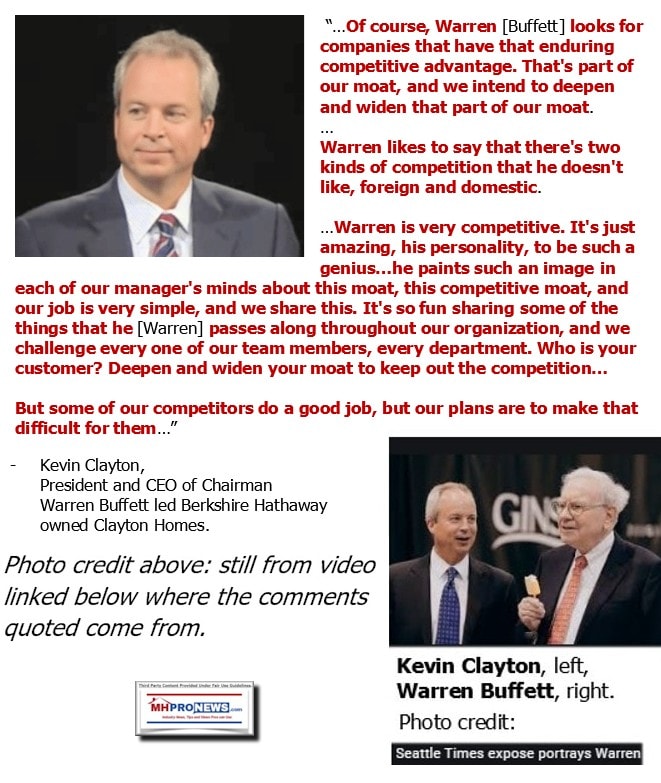
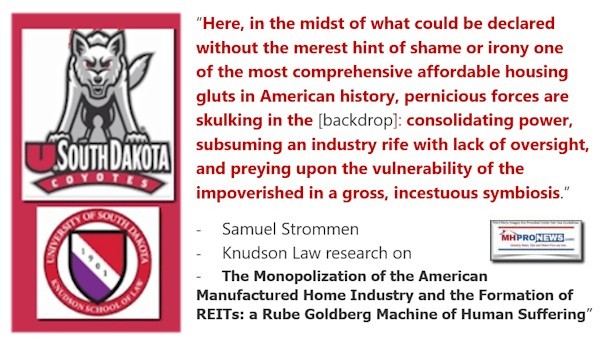

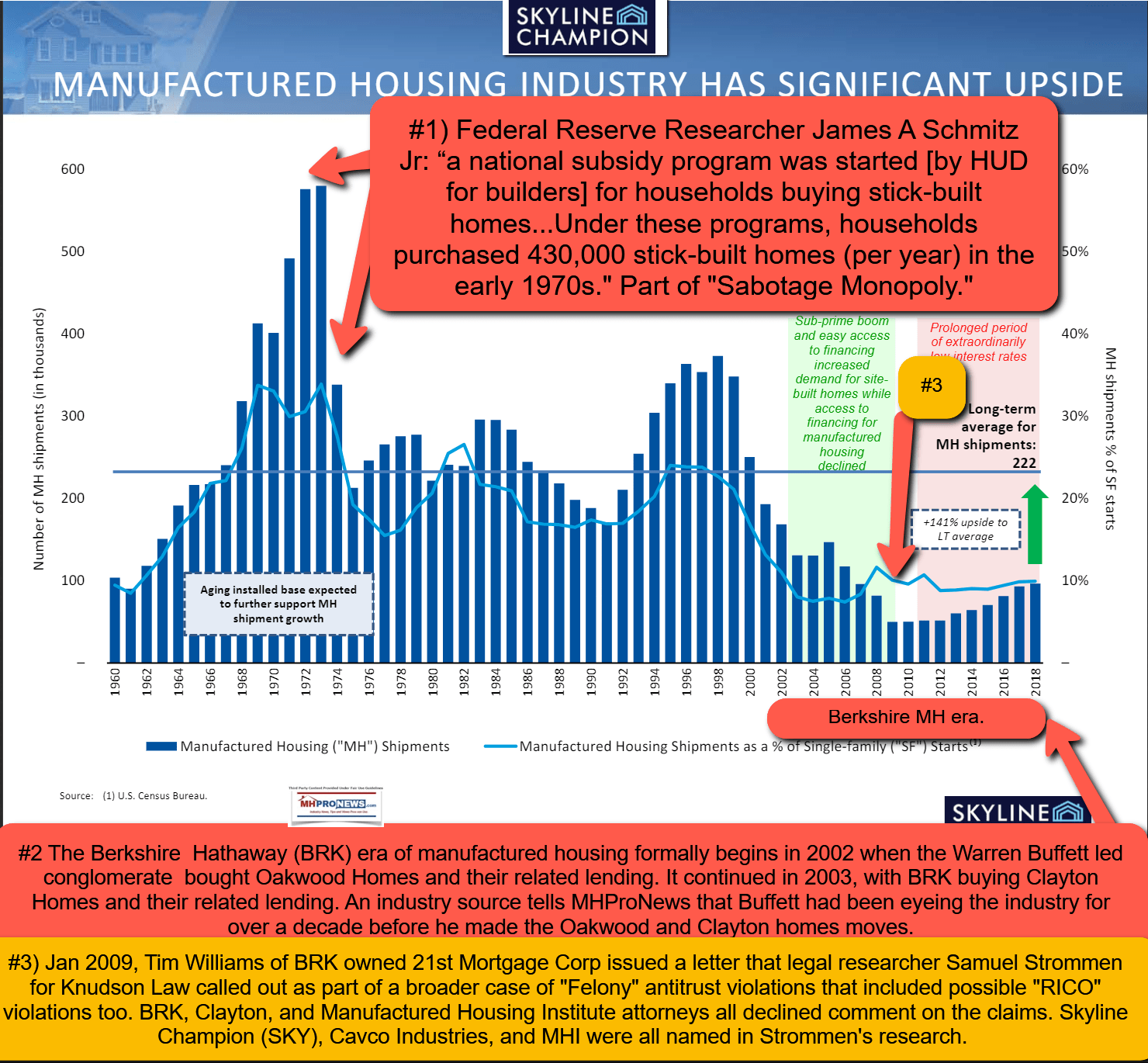
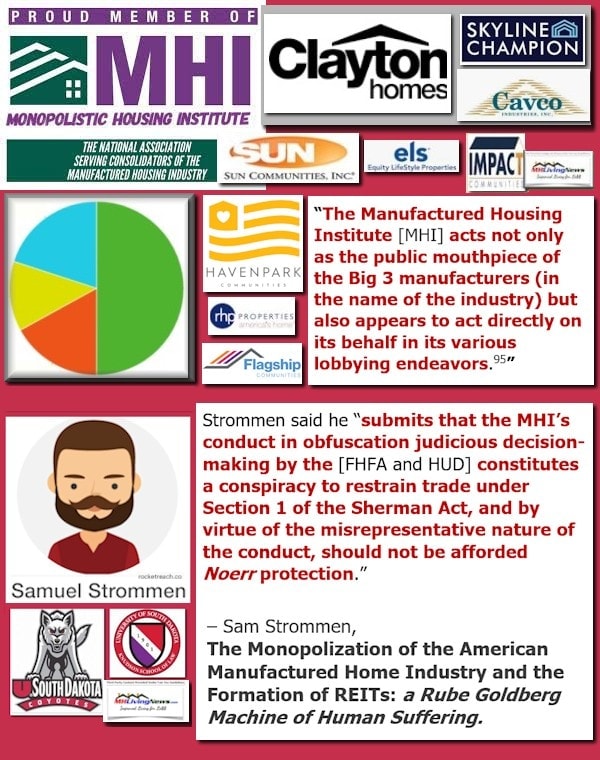
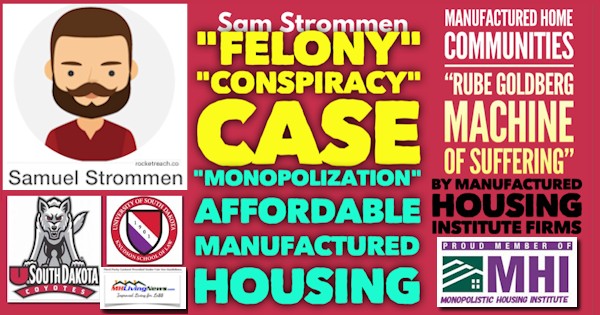
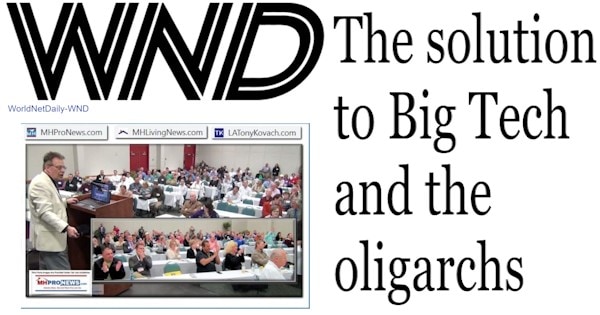
need to wait years for legislation that in the past has often led to little or no discernable benefit. https://www.wnd.com/2021/05/solution-big-tech-oligarchs/
Despite the ongoing stream of deceptive and misleading remarks by those who are arguably consolidating the manufactured housing industry in plain sight of antitrust regulators, part of the cure must be continual exposure of how specific claims, statements, and remarks by MHI insiders relates to the historic pattern and bigger picture.
It isn’t easy, but it is necessary if those who have wrongfully deprived thousands of manufactured housing industry professionals of their rights are to be held accountable.
Note that an attorney recently told MHProNews that even if an instance of an antitrust, RICO, or other legal violation occurred in the past – but is part of an ongoing scheme – then the statues of limitations on those prior purported illegalities has not expired under the law. Meaning, those examples previously reported by MHProNews/MHLivingNews, Sam Strommen, and others could still be used to charge industry insiders with felony violations of the law. Here is how the DOJ website stated it: “an overt act in furtherance of the conspiracy, the statute of limitations begins to run on the date of the last overt act.” Emphasis added and stay tuned to MHProNews for more of the reporting that no one else in MHVille trade media dares to bring you. ###
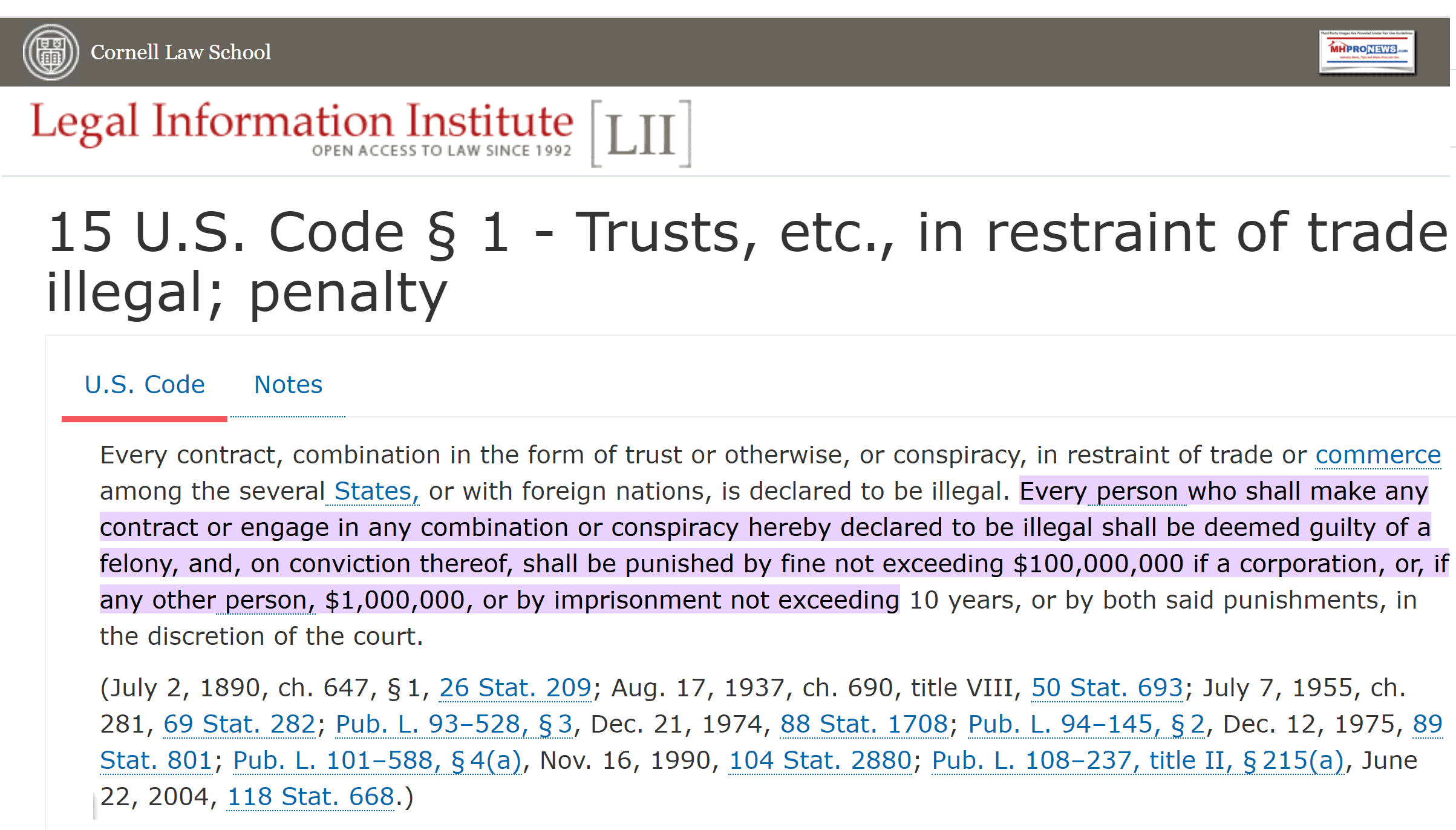


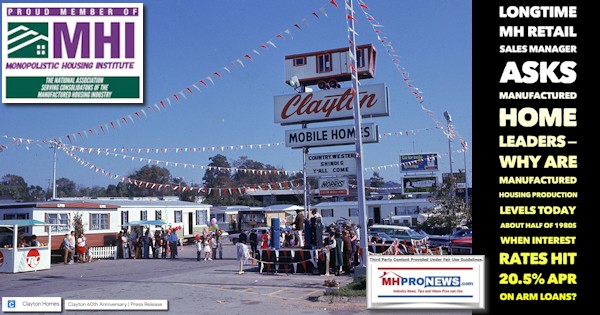
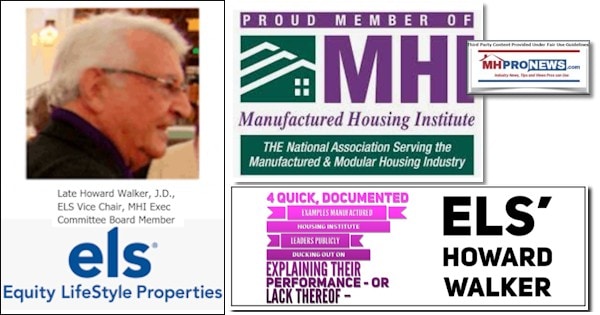
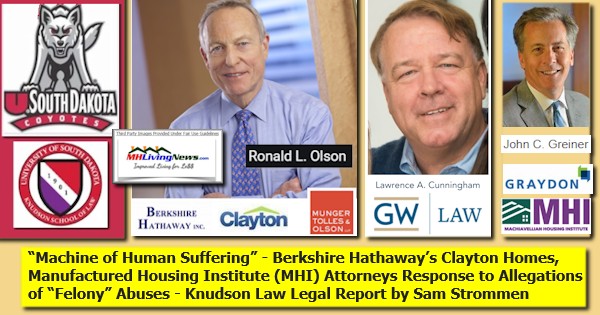

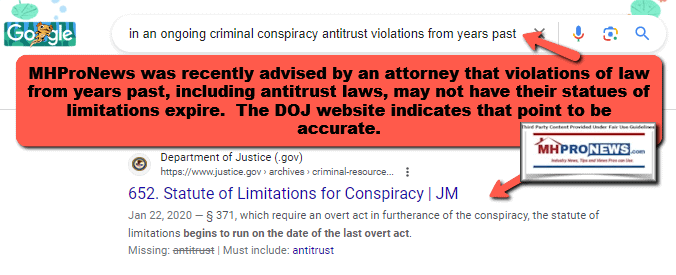

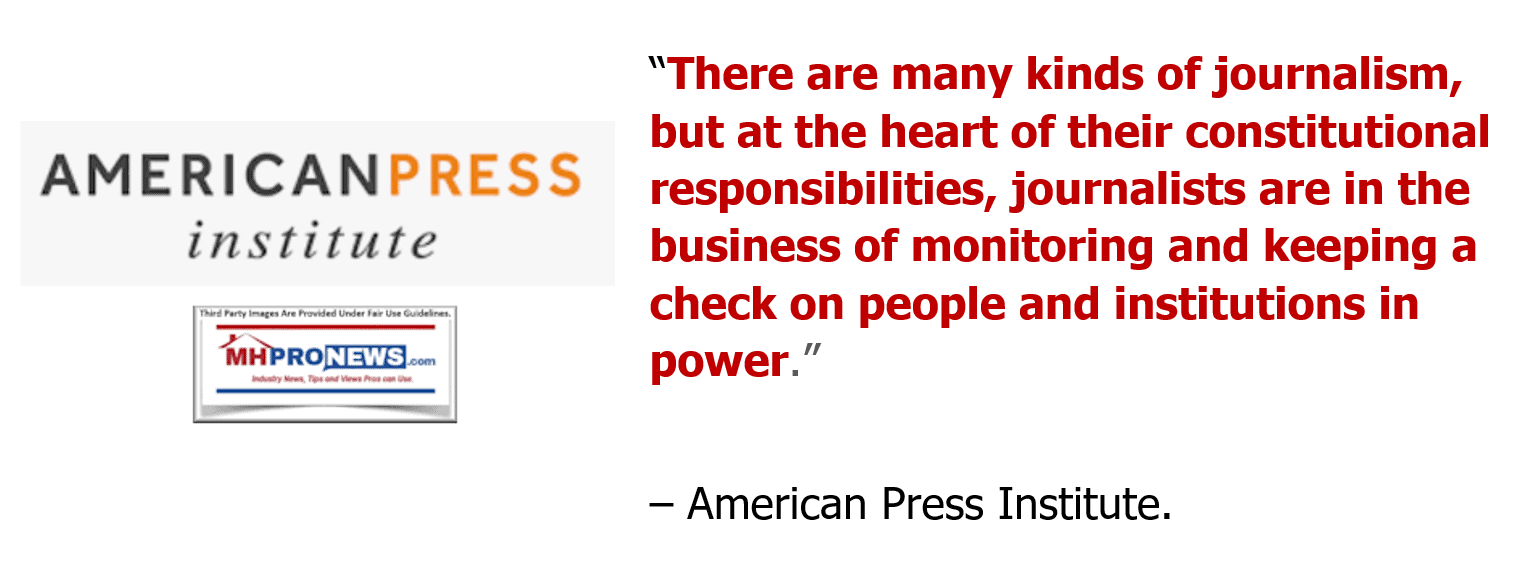

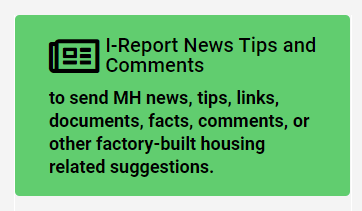
Again, our thanks to free email subscribers and all readers like you, as well as our tipsters/sources, sponsors and God for making and keeping us the runaway number one source for authentic “News through the lens of manufactured homes and factory-built housing” © where “We Provide, You Decide.” © ## (Affordable housing, manufactured homes, reports, fact-checks, analysis, and commentary. Third-party images or content are provided under fair use guidelines for media.) See Related Reports, further below. Text/image boxes often are hot-linked to other reports that can be access by clicking on them.)

By L.A. “Tony” Kovach – for MHProNews.com.
Tony earned a journalism scholarship and earned numerous awards in history and in manufactured housing.
For example, he earned the prestigious Lottinville Award in history from the University of Oklahoma, where he studied history and business management. He’s a managing member and co-founder of LifeStyle Factory Homes, LLC, the parent company to MHProNews, and MHLivingNews.com.
This article reflects the LLC’s and/or the writer’s position and may or may not reflect the views of sponsors or supporters.
Connect on LinkedIn: http://www.linkedin.com/in/latonykovach
Related References:
The text/image boxes below are linked to other reports, which can be accessed by clicking on them.’

